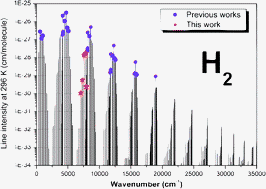Five very weak transitions—O(2), O(3), O(4), O(5) and Q(5)—of the first overtone band of H2 are measured by very high sensitivity CW-Cavity Ring Down Spectroscopy (CRDS) between 6900 and 7920 cm−1. The noise equivalent absorption of the recordings is on the order of αmin ≈ 5 × 10−11 cm−1 allowing for the detection of the O(5) transition with an intensity of 1.1 × 10−30 cm per molecule, the smallest intensity value measured so far for an H2 absorption line. A Galatry profile was used to reproduce the measured line shape and derive the line strengths. The pressure shift of the O(2) and O(3) lines was accurately determined from a series of recordings with pressure ranging between 10 and 700 Torr. From an exhaustive review of the literature data, the list of H2 absorption lines detected so far has been constructed. It includes a total of 39 transitions ranging from the S(0) pure rotational line near 354 cm−1 up to the S(1) transition of the (5-0) band near 18 908 cm−1. These experimental values are compared to a highly accurate theoretical line list constructed for pure H2 at 296 K (0–35 000 cm−1, intensity cut off of 1 × 10−34 cm per molecule). The energy levels and transition moments were computed from high level quantum mechanics calculations. The overall agreement between the theoretical and experimental values is found to be very good for the line positions. Some deviations for the intensities of the high overtone bands (V > 2) are discussed in relation with possible pressure effects affecting the retrieved intensity values. We conclude that the hydrogen molecule is probably a unique case in rovibrational spectroscopy for which first principles theory can provide accurate spectroscopic parameters at the level of the performances of the state of the art experimental techniques.

You have access to this article
 Please wait while we load your content...
Something went wrong. Try again?
Please wait while we load your content...
Something went wrong. Try again?


 Please wait while we load your content...
Please wait while we load your content...